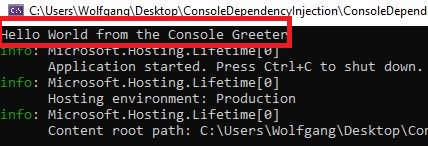Just the root command to show the help text and see the configuration is working as expected lesson student. Var builder new ContainerBuilder.

Dependency Injection In A Net Core Console Desktop Apps Thecodebuzz
Dotnet new console --name DiConsoleApp.

. Add the following NuGet package before writing any logic here MicrosoftExtensionsDependencyInjection. NET supports the dependency injection DI software design pattern which is a technique for achieving Inversion of Control IoC between classes and their dependencies. Private static void RegisterServices var collection new ServiceCollection.
For applications that dont use dependency injection consider. Adding DI to a console app. The simple one.
Autofac is a popular opensource DI framework for the NET platform. To demonstrate the approach Im going to create a simple application that has two services. Therefore it is time to add Net Core DI framework to the code.
Once the project is created open the project in a Visual Studio Code window and start by adding an appsettingsjson file. Tweak the Worker Service template. This will run after the dependency injection container has been built.
To add configuration in a new NET console application add a package reference to MicrosoftExtensionsHosting. I usually prefer option 3 so any changes you make in the appsettingjson file in your main web project will also take effect in. Application code should start here.
Extension methods for setting up Redis distributed cache related services in an IServiceCollection. Redis Cache Service Collection Extensions. Dotnet new console -n SampleApp.
One way you could do is having a static class ServiceLocator which is initialized only from the beginning. Other popular C choices include Hiro. Modify the Programcs file to match the following code.
Visual studio will scaffold a project for you which will end up looking like this. This class exposes a readonly ServiceProvider and you can call it to get the thing you register. It makes sense that if you want a console application you would select the Console Application template when.
For example the following installs the dotnet-trace global tool and starts a simple ASPNET Core NET 6 app collecting the DI events. A Dependency Injection Container is the central location in your app that manages your dependencies and provides the features to inject and configure their lifetime scopes. Firstly I will install the Dependency Injection NuGet package MicrosoftExtensionsDependencyInjection.
Here call CreateHostBuilder which will return an IHost which contains all of the services. First thing is to add Autofac NuGet packages to NET Core console application project. Using Autofac is simple and we need only small changes in our code to make it work.
Lets build the project and run some commands and see what they display. 2 Copy the existing appsettingsjson file from your web project into your new one. You may read somewhere else or someone else here may comment this is anti-pattern which is generally out of context.
In Main which is the console applications entry point create the host and run the program. The first service is an email service with a single method. Polly Service Collection Extensions.
The first thing is to add Autofac NuGet packages to the NET Core console application project. Before we get into the bootstrapping the console application lets create a few services. Autofac is my container framework of choice in the code template.
As mentioned above in point 1 we need to create a collectioncontainer to hold the services information as follows var collection new ServiceCollection. Dependency injection in NET is a built-in part of the framework along with configuration logging and the options pattern. If you decide the built-in container is the right approach then adding it to your application is very simple using the MicrosoftExtensionsDependencyInjection package.
A dependency is an object that another. Or 3 Add a link from the existing appsettingsjson file to your new project. Note that since a console application doesnt come with any such file by default template we would want to add one since were so accustomed with.
Secondly once the package is added I will create a class ContainerConfiguration to register for all the classes. Build and Run Commands. First thing first lets create a new project.
Open up Visual Studio hit CtrlShiftN and select the Console Application NET Core project type from the templates. Create a new Console App. Add a public Run method to execute your service code.
We will start by creating our application inside our terminal. With Autofac packages in place we can change RegisterServices method to use Autofac. Dotnet tool install-g dotnet-trace dotnet trace collect --providers Microsoft-Extensions-DependencyInjectionVerbose -- name aspnettestexe The resulting trace can be viewed in PerfView on Windows.
Use the Console Application template and use the same system as in the Worker Service template. Once the application has been create open the application in Visual Studio Code and let us build and the application to make sure everything is working. Provides convenience extension methods to register IPolicyRegistry and IReadOnlyPolicyRegistry in the service collection.
With these changes in place we can now compile our command-line app and use the MicrosoftExtensionsDependencyInjection engine. Use this method when using dependency injection in your application such as with ASPNET Core. Use the Console Application template and add dependency injection to it.
Now that all the refactoring is done. Public static MicrosoftExtensionsDependencyInjectionIServiceCollection AddDbContext this. Using IHost host HostCreateDefaultBuilder argsBuild.
1 Create a custom settings file for your new project.
How To Implement Dependency Injection In Net Core Console Application

Creating A Console App With Dependency Injection In Net Core

Dependency Injection In A Net Core Console Desktop Apps Thecodebuzz

Configure Dependency Injection For Net 5 Console Applications Programming With Wolfgang

Lesson 1 5 Setting Up Dependency Injection Components Darthpedro S Blog

Config Dependency Injection In Net Core Console Application

Config Dependency Injection In Net Core Console Application

Using Dependency Injection In A Net Core Console Application Puresourcecode
0 komentar
Posting Komentar